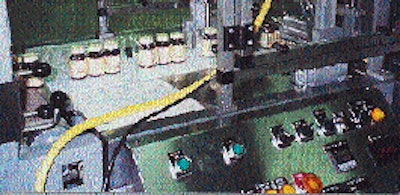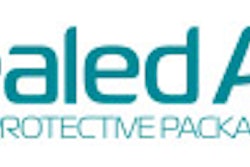Pharmavite's 500ꯠ-sq-ft San Fernando, CA, vitamin, mineral and food supplement manufacturing plant buzzes with the activity of 15 packaging lines that produce hundreds of product varieties. Approximately 60% of that output is for the firm's own Nature Made® brand; the balance is contract packaged for competitive offerings. Headquartered in nearby Mission Hills, CA, Pharmavite is a wholly-owned subsidiary of Otsuka America, a part of Japanese-based Otsuka Pharmaceutical Co., Ltd. At the San Fernando plant, packaging includes 10 lines that fill amber-tinted polystyrene bottles in sizes from 50 to 500 cc, at speeds to 120 bpm. About 80% of this production is shrink wrapped into bundles of three or six. Five additional "mini" lines are used for very small lot runs or larger, bulkier containers. These lines run at much slower speeds than the 10 bottle filling lines. These products are subsequently bundled on L-bar sealers. Within the past two years, Pharmavite has added four TS37 shrink wrapping systems from Great Lakes (Chicago, IL), to serve four of the 10 high-volume packaging lines. As a result, product changeover time on these lines has been halved, speeds have increased by 20 to 40 bpm, and maintenance has been reduced. WestPack influence Curiously, Pharmavite discovered the TS37 at WestPack '93 in Anaheim, CA. (For a preview of WestPack '95, see page 42). "At that time, we were installing a new packaging line and we needed a shrink wrapper relatively quickly," recalls Michael Georgeson, facilities and maintenance manager at Pharmavite's San Fernando plant. "We had noticed their publicity and advertisements, and had read stories about their products and services in trade publications. We went to the show to see the machine. We bought the unit that was on display." They also acquired the supplier's MPD102260 shrink tunnel to go with the shrink wrapper. Since then, Pharmavite has added three more TS37 systems to new lines. Infeed requirements While the order of additional machines confirms Pharmavite's satisfaction with its new shrink wrappers, the addition of the first unit from WestPack '93 was no cure-all. "The problem for us," notes Georgeson, "was that we had no efficient way of taking finished bottles from our packaging line and putting them into the shrink wrapper. "At first we did it by hand," he continues. "Then we contracted a separate company to design a temporary infeed. That worked for a while, but we realized we weren't getting the finished product that we needed." Great Lakes sent an engineering team to the San Fernando plant that worked with Pharmavite to meet a 15-point requirement list for the machine and infeed. Among the changes Great Lakes made, according to Georgeson: * The infeed belt, one of three belts used on the Great Lakes equipment, is narrower than that of the temporary infeed. This helps speed sealing of the leading and trailing edge of each bundle. * Using programmable logic controllers and temperature controllers from vendors Pharmavite was already using helps make the systems compatible. * Pilot lights were added for each inlet, exit and trim-seal clutch to ease maintenance. "If there's a jam on the line, one of the clutches will go out. There's three separate clutches on the machine. Since you have to remove cover plates to check each clutch, you may remove one, find that clutch is still working, then have to replace that plate and go on to the next one. That would have been time consuming." These access doors were also made more functional to ease entry. * Redesigned safety circuitry permits the safety button to be engaged such that only output power drops. This allows the downstream heat tunnel to continue to function. * The 6' infeed, added to the wrapper and shrink tunnel, fit within a 14'-long area to maximize space within the plant. "We gave Great Lakes stringent requirements and they came through for us," Georgeson says. "With the TS37s, we have no major delays or problems, and that's a big improvement over the old systems." Prior to shrink wrapping, bottles are unscrambled, filled, cotton is inserted, then the bottles are capped, labeled, induction heat sealed and neck bands are applied. Bottles discharge onto an accumulation table, then proceed into the infeed of the TS37. A photo-eye senses bottles as they index along the infeed's belted conveyor. Bottles are sold primarily in groups of three, with a limited number of six-packs. For three-packs, bottles proceed single file down one lane or channel. Six-packs are diverted into two channels, with three bottles per channel. Bottles for each grouping are held within a "lug" on the conveyor to help prevent bottles tipping during the process. Another photo-eye counts bottles. After three bottles pass, a metal cylinder moves between bottles to separate them into a group. Each group of bottles is then conveyed into the machine's forming area. Cryovac's (Duncan, SC) D955 60-ga polyolefin film comes from an unwind unit below the machine, proceeding over a series of dancer rollers. The film continues upward where a plow centerfolds it into a funnel around the incoming group of bottles. Radiant heat is used to form the side seal. The side-sealed unit continues to the next station where a seal bar descends and uses heat, at temperatures between 225 and 250° F, to cross-seal the leading edge of the package. The seal bar then ascends as the package moves ahead. The entire process is timed so that the seal bar again descends at the point necessary to create the cross seal and cut-off at the trailing package edge. This completes the three-sided seal. The pack then goes through the shrink tunnel where bottles are completely wrapped in film, with no bullseyes. "We had a customer that insisted upon no bullseyes, so we treated that request as a 'worst-case scenario' and decided to eliminate the use of bullseyes with all our packs," says Georgeson. Standardization "We try to standardize most of our packaging machinery," says Georgeson. "In other words, we try to use the same vendor for the filler on all the lines, the same capper, and so on. By doing this, our training, maintenance and change parts ordering are smoother. But with our shrink wrappers, it's been different. "For some reason," he says, "we've purchased one of this machine and two of that. Many of these machines are getting old and are not functioning up to par. We are normally faced with two or three changeovers on a line per shift, sometimes more. Most of our older wrappers required different plows for different bottle sizes, so it would take maybe 20 minutes to set up a different product. Certain parts, such as cams, became unavailable. Maintenance and changeovers became costly." Georgeson says product size changeovers on the TS37 take 10 minutes, which frees mechanics to attend to other needs within the packaging area. Switching to a different product on the machine requires relatively simple adjustments for width of infeed, film, the rate of a product transfer mechanism and speed settings. Pharmavite standardized by using the TS37 shrink wrappers for its three newest lines. All four lines operate at 120 bpm speeds, compared with 80 to 100 bpm speeds possible on the older shrink wrappers. Since these lines run 24 hours a day, and either five or six days a week, that productivity results in considerably greater output. "The TS37 systems are a huge success," says Georgeson. "They allow us to fulfill our production schedules and they provide us with the quality we demand."


























